Flavorful, hearty, utterly scrumptious, and one of the most popular Indian Street Food – Pav Bhaji!
It is a spicy mashed vegetable dish, served piping hot with a dollop of butter, diced red onions, cilantro, a squeeze of lime, and buttery toasted pav on the sides. Is your mouth watering yet? Mine sure is.
This recipe is a treat to your eyes, tongue, tummy, and soul! 🙂
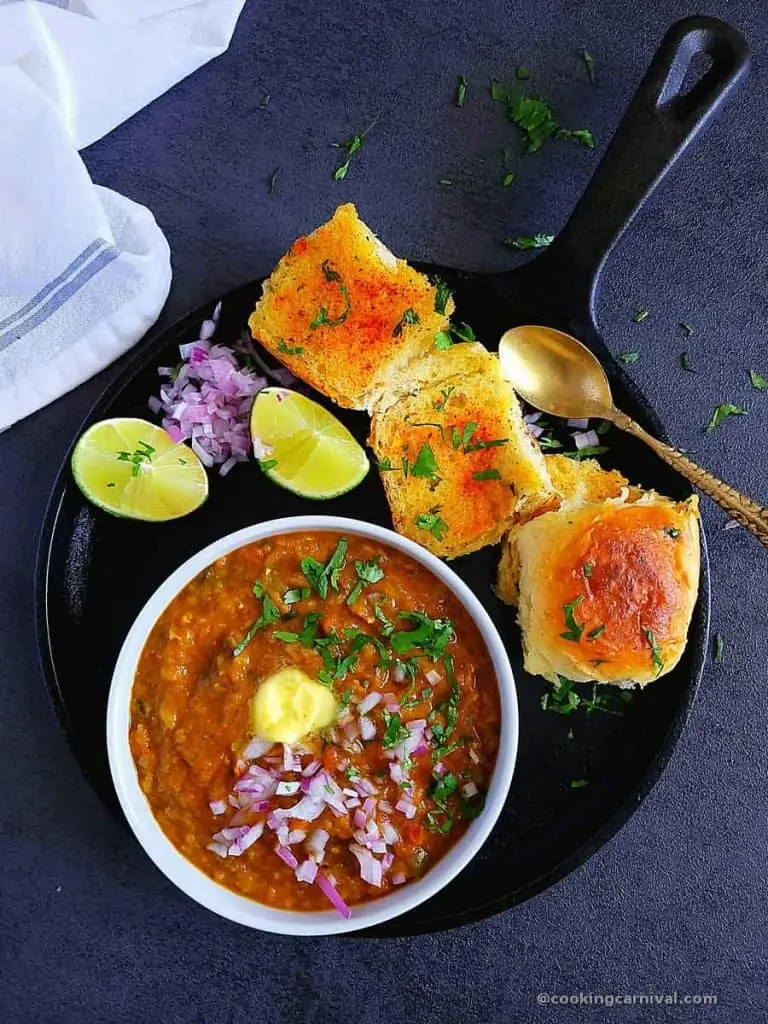
Jump to:
- What is Pav Bhaji?
- Why you will make this recipe?
- What is so special about my pav bhaji recipe?
- Ingredients required
- What is the best type of bread to serve with this spicy bhaji?
- Homemade Pav Bhaji Masala:
- Step by step process of making Pav Bhaji recipe
- Notes, pro-tips, and quick FAQs
- More Indian Street food recipes
- Pav Bhaji
- Video
I have been a huge pav bhaji fan since childhood. You can find it pretty much everywhere in India if you want to taste the best pav bhaji, go to Mumbai!
This dish is originated from Mumbai (also known as Bombay) and the one at Juhu Beach is very famous and is so delicious.
What is Pav Bhaji?
Pav Bhaji(also known as Bhaji Pao) is popular Indian street food originating from Mumbai. It has now become popular not just in India but all over the world.
- Pav means bread.
- Bhaji in Marathi means vegetable dish.
Pav bhaji consists of bhaji (a thick potato, cauliflower, tomatoes, onion, and bell pepper-based curry) garnished with coriander, a dollop of butter, chopped onion, and a dash of lemon and lightly toasted pav. The pav is usually buttered on all sides and then pan-fried.
A special blend of spices known as pav bhaji masala is used to flavor the dish.
Pao Bhaji came into existence in the 1800s when cotton mill workers in the city had to work for long hours and would often miss their meals and remain hungry. So pav bhaji was that easy quick meal that was invented to feed these workers during those times.
There are many versions of making it.
- Some make it with raw bananas without any root vegetables. It is called Jain Pav Bhaji.
- Some make it without mashing the vegetables known as Khada Pav bhaji where vegetables are not mashed (khada=straight).
- Some add cheese and paneer.
- Green bhaji and black bhaji are also available nowadays.
Like everything else, there are now endless variations on Pav Bhaji and the ingredients used.
Why you will make this recipe?
- It’s a versatile recipe, whether you’re hosting friends for game day, perfect for potluck or gatherings, or looking for a quick weeknight dinner,
- This is the kind of dish that the pickiest kids will love.
- You can use pretty much any vegetable. So it’s a perfect “clean your fridge” type of meal.
This is one dish I can spend my entire life on without getting bored. Hahaha….
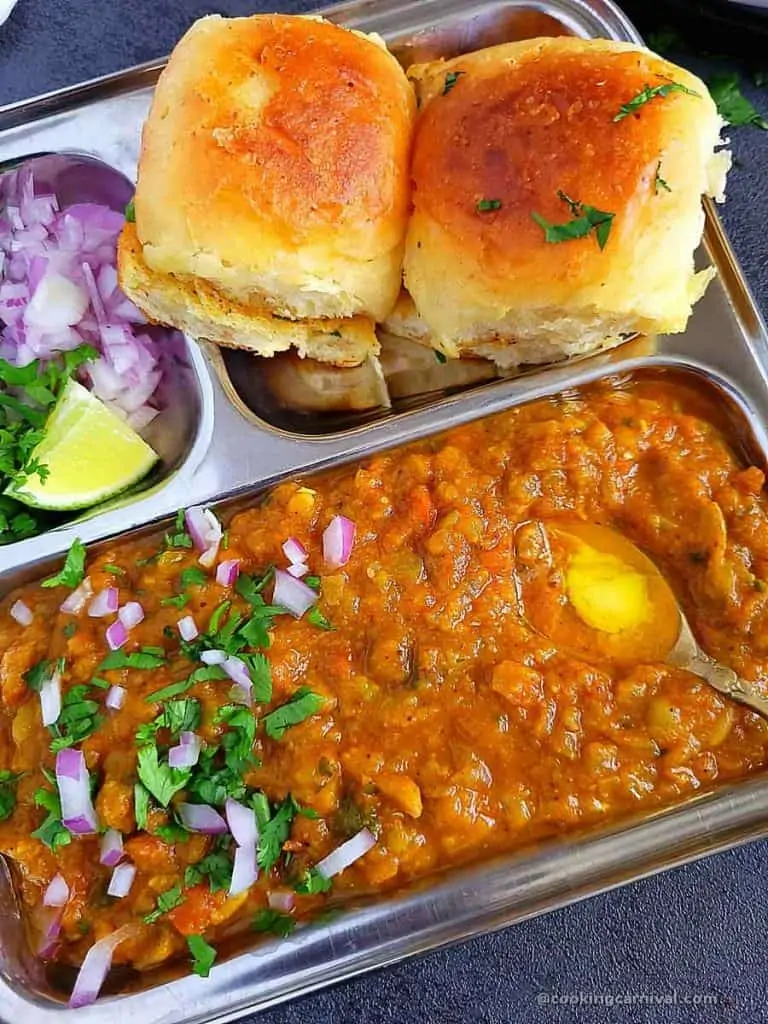
What is so special about my pav bhaji recipe?
You will find hundreds (maybe thousands) of Pav Bhaji recipes on Google and YouTube and I know you are thinking what’s so special about my recipe.
I am a big-time street food lover and when it comes to recreating them at home, I never compromise on ingredients and never take shortcuts in making them.
I have tried Pao Bhaji million times to get the perfect color, taste, and texture recipe just like we get in Mumbai. So from my trial, I found some key factors to make it perfect.
- 1. Dried green peas – One secret ingredient is dried peas(cooked). The restaurants and street food stalls use cooked Dried green peas to make bhaji instead of fresh green peas. Green peas are seasonal in India (I know nowadays Frozen peas are available) and they are expensive when not in season. So they use dried green peas throughout the year. Plus dried green peas help in getting a creamy texture. Sometimes, green peas make bhaji sweeter. So I prefer to use cooked dried peas. To make the process a little easy, I cook dried green peas in bulk and store them in the freezer for future use.
- 2. Garlic chutney – Making garlic chutney in Kashmiri red chili powder and then using it to make this recipe is a game-changer. It gives perfect color so you don’t need to use any food coloring. Sauteed garlic chutney is a beautiful sense for the taste buds. It creates flavor and adds a bit of complexity to this pav bhaji recipe. When we sauté this chutney in butter, they release their perfume into the air and their flavors into the butter. There’s something so satisfying about that moment when you add garlic chutney or just chopped garlic in your frying pan and it comes into contact with the hot butter for the first time. Isn’t it?
- 3. Vegetables – There are 5 vegetables that I strongly suggest you use – potatoes, onions, tomatoes, green bell peppers, and cauliflower. This typically produces the taste and texture that’s closest to what you find in India. Sure you can use other vegetables but it won’t taste as good. I don’t care about how much other vegetables provide Vitamins. With street food, the taste is king.
- 4. Adding bhaji masala while cooking/steaming the vegetables. I always add some pav bhaji masala while boiling vegetables. It enhances the flavors of this bhaji more.
Ingredients required
Making Paav Bhaji at home is very easy and requires ingredients that are easily available in the market.
- Vegetables – If you eat on the streets of Mumbai, most vendors use potatoes, and bell peppers. But I also add a little bit of cauliflower on top of the above veggies. This combination of vegetables produces the best taste and texture that’s closest to what you find in India. Don’t substitute green peppers with red, orange, or yellow-colored bell peppers. They tend to be sweet and ruin the dish. Other vegetables are okay too! I’ve seen some use beets to enhance the flavors and colors. Some also add French beans, carrots, eggplants, cabbage, and bottle gourd (Lauki). Do not use okra, pumpkin, corn, yam, sweet potato in this recipe.
- Dried green peas – It binds bhaji so well and gives Mumbai roadside bhaji taste. Plus dried green peas are protein-packed so it’s healthy too. If you think cooking dried green peas separately is a time-consuming and tedious job, you can substitute it with green peas. But I highly encourage you to try making this recipe with dried green peas. You will notice a huge difference.
- Tomatoes – I use fresh Roma tomatoes. Make sure you use red ripe tomatoes. It gives a beautiful color to the bhaji. You can use Diced or pureed tomatoes too. If you are going to use diced tomatoes, blend them up before you use them.
- Onions – Onions work as the aromatics here. You can use any onions but red onions work best.
- Garlic – You will need a good amount of fresh garlic to make Mumbai-style pav bhaji. Don’t use garlic powder or bottled minced garlic.
- Pav bhaji Masala – The main flavor in the bhaji comes from a special blend of spices – pav bhaji masala. You can easily get it from the Indian grocery store or make it at home (sharing recipe below). My personal favorite is Everest Pav Bhaji Masala.
- Other spices – You will also need turmeric powder, chili powder, and salt. Use Only Kashmiri red chili powder to get the beautiful street style red color.
- Kasuri Methi – I love a little bit Kasuri methi in my bhaji. It’s optional but highly recommended.
- Butter – This is the hero of the dish. A good quality butter makes all the difference. Make sure to use salted butter. My personal favorites are Amul and Kerry Gold salted butter. If you want the paav bhaji to taste just like Mumbai street style or fast food restaurant then do not compromise on the amount of butter used.
- Oil – I have also added some oil with butter.
- Other than the above ingredients, you will need lime wedges, cilantro, Dinner rolls (pav), and finely diced onions.
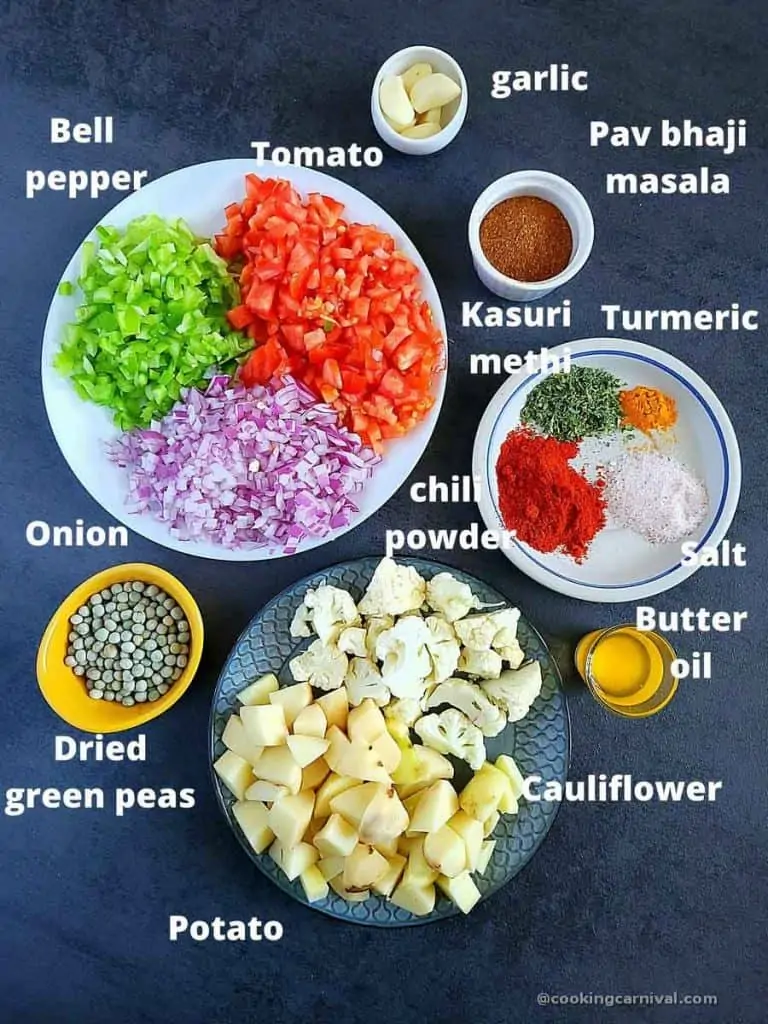
What is the best type of bread to serve with this spicy bhaji?
My favorite bread is this, Homemade Ladi Pav. It tastes just like we get in India. Or serve your pav bhaji with unsweetened or very lightly sweet bread. Buy bread that has 3 grams or less of sugar.
Homemade Pav Bhaji Masala:
If you want to make bhaji masala at home, here is the recipe –
- 1 tablespoon fennel seeds
- 1-inch cinnamon sticks (or 1 teaspoon cinnamon powder)
- 4 tablespoons coriander seeds
- 1 tablespoon cumin seeds
- 2 green cardamoms
- 5 cloves
- 1 teaspoon black peppercorns
- 2 count mace/javitri
- ¼ teaspoon turmeric
- ½ teaspoon black salt
- 1 tablespoon Kashmiri red chili powder
- 2 teaspoon Amchur Powder
Dry roast all of the above whole spices (except Kashmiri red chili powder, turmeric powder, salt, and aamchur powder) on medium heat. Allow the spices to cool down. Add the roasted spices along with Kashmiri chili powder, turmeric powder, salt, and amchur powder to a grinder jar and make a fine powder, Store in an airtight container.
Step by step process of making Pav Bhaji recipe
Step – 1 Soaking dried green peas (skip this step if you want to use fresh or frozen peas)
Rinse dried green peas 2-3 times under cold water. Soak them in 1 ½ cup water overnight or for 8 hours. (Image 1)
Notes – 1. You can cook a big batch of dried green peas and freeze in one-time use portion size for whenever you want to make Bhaji.
2. You can use fresh green peas(matar) or frozen green peas too instead of dried green peas.
Step 2 Cooking vegetables and soaked green peas.
Once the green peas are soaked, discard the water. Place the soaked peas in a bowl, add ¾ cup of water, and cover the bowl. Keep it aside. (image 2)
Chop the cauliflower into florets. Peel the potatoes, and chop them into quarters. I like peeling mine before boiling. Take these vegetables into a bowl; add ½ teaspoon of pav bhaji masala and 1 cup of water. (if you are using fresh or frozen matar(green peas, add it with cauliflower and potatoes). (image 3)
Now take a pressure cooker add 2 cups of water, place the bowl of vegetables, cover it and place dried green peas bowl (Covered) on top. (image 4 to 7)
Now close the pressure cooker and take 7-8 whistles. (image 8)
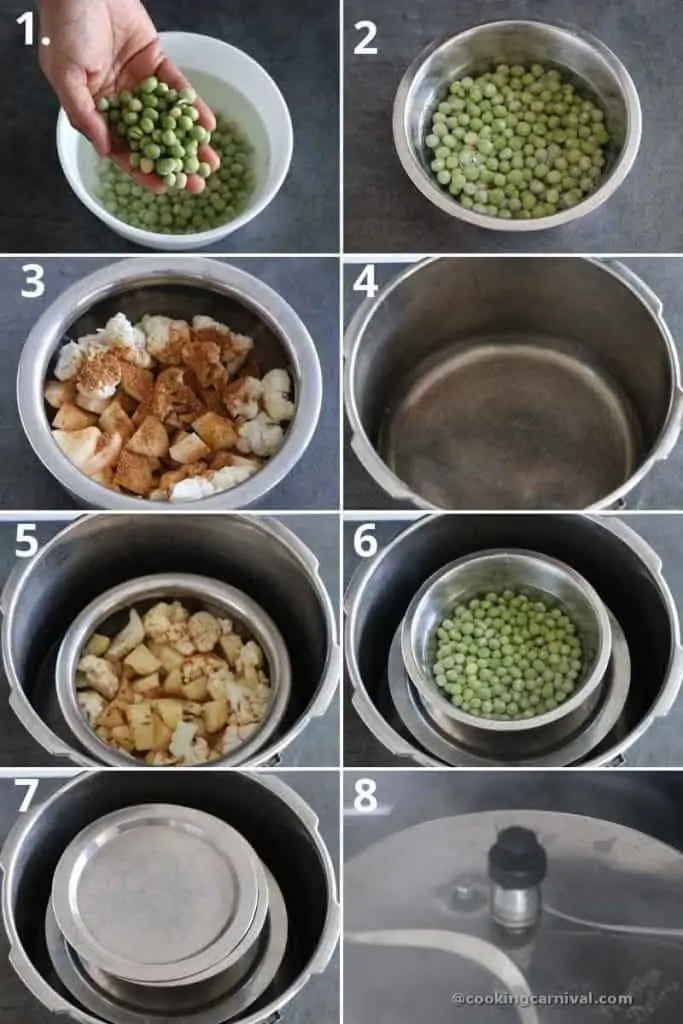
Once pressure is down, open the pressure cooker and take out both the bowls.
Note – The vegetables and dried green peas have be to cooked completely.
Take peas and vegetables in a bowl and mash them together really well-using potato masher. Keep it aside. (image 9 to 11))
Making garlic chutney (do this step while the vegetables and dried green peas are presser cooking)
Take garlic and Kashmiri red chili powder in a blender. Add ¼ cup of water and blend them into smooth chutney. Keep it aside. (image 12 to 14)
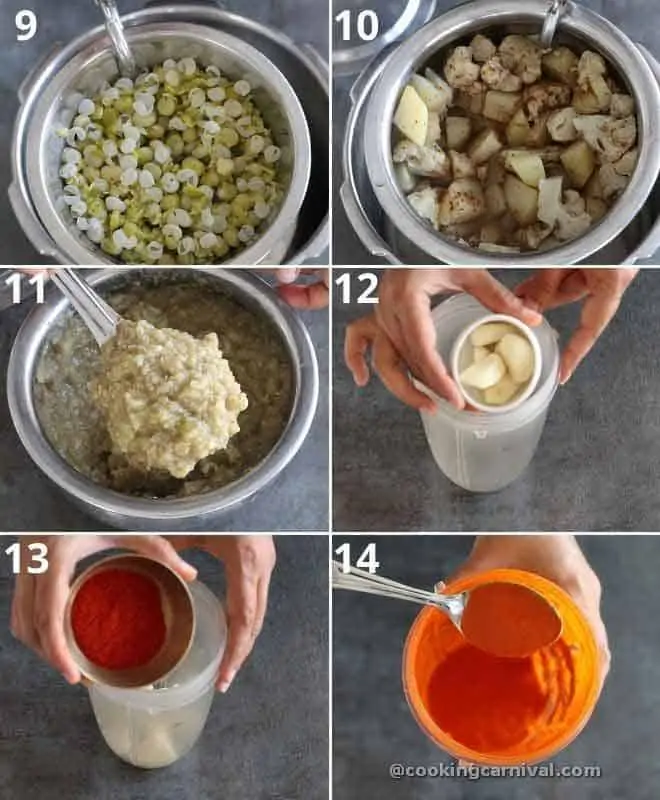
Step – 3 Cooking Pav Bhaji
Heat 1 ½ tablespoon butter and 1 tablespoon oil in a pan/pot. (image 15)
Now add garlic chutney and sauté for about a minute, stirring continuously. (image 16)
Now add onions, sauté for a minute and then add tomatoes, bell pepper, and salt. (image 17,18 and 19)
Saute everything for about a minute. Cover the pot and let everything cook for about 4 to 5 minutes on medium heat. Stir once or twice in between to make sure nothing is sticking to the pot. (image 20)
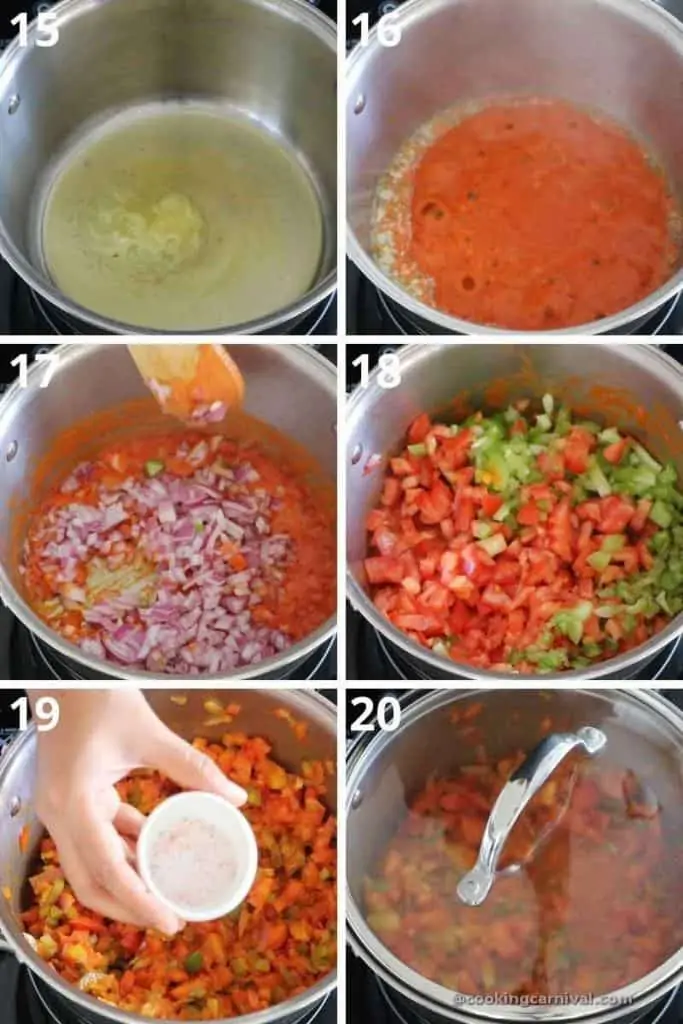
Open the lid, lower the heat and mash everything with a potato masher. (image 21 and 22)
Now add 1 cup of water, remaining 1 tablespoon pav bhaji masala, and turmeric powder. Mix everything well. Cover and again cook it for 6 to 7 minutes on medium heat. Make sure to stir occasionally and check-in between nothing in sticking to the pan. (image 23)
Now open the lid, stir the bhaji and again add ¾ cup of water and mix.
Lower the heat, add mashed vegetable-dried peas mixture and mix well. (image 24)
Let it simmer for about 5 minutes on low to medium heat.
Add Kasuri methi, cilantro, and ½ tablespoon butter. Mix well. Cook it for 1 minute and switch off the flame. (image 25 and 26)
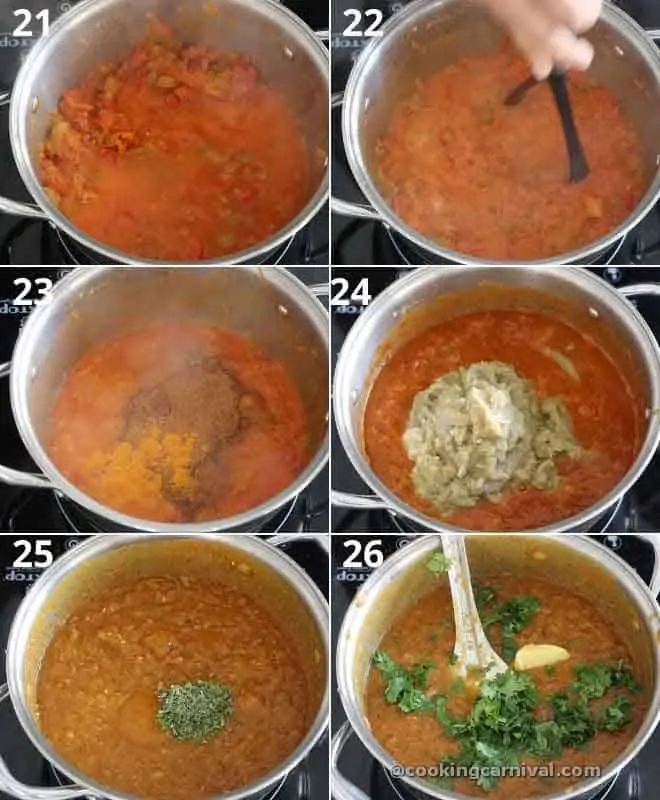
Step – 4 Toast the Pav
To toast the pav, melt butter on a pan on medium heat. Sprinkle some pav bhaji masala and some cilantro on top of the butter halves the bun (pav) from the middle, and then place the buns on the pan. (image 27 to 29)
Press to toast the pav until crisp and golden brown from both sides. (image 30)
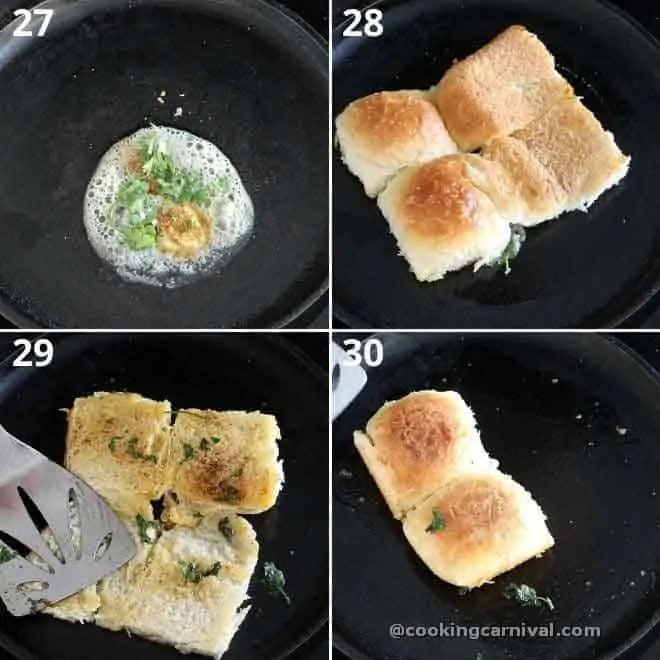
Step – 5 Serve the Pav Bhaji
To serve the pav bhaji, place a ladle full of hot bhaji on a plate. Sprinkle onion, cilantro and add a dollop of butter. Serve with toasted pavs and a side of a lemon wedge. Enjoy.
Very Important note – This pav bhaji recipe is very spicy. The spice level of this is ⅘. Reduce the amount of chili powder if you are making for kids or if you don’t prefer spicy bhaji.
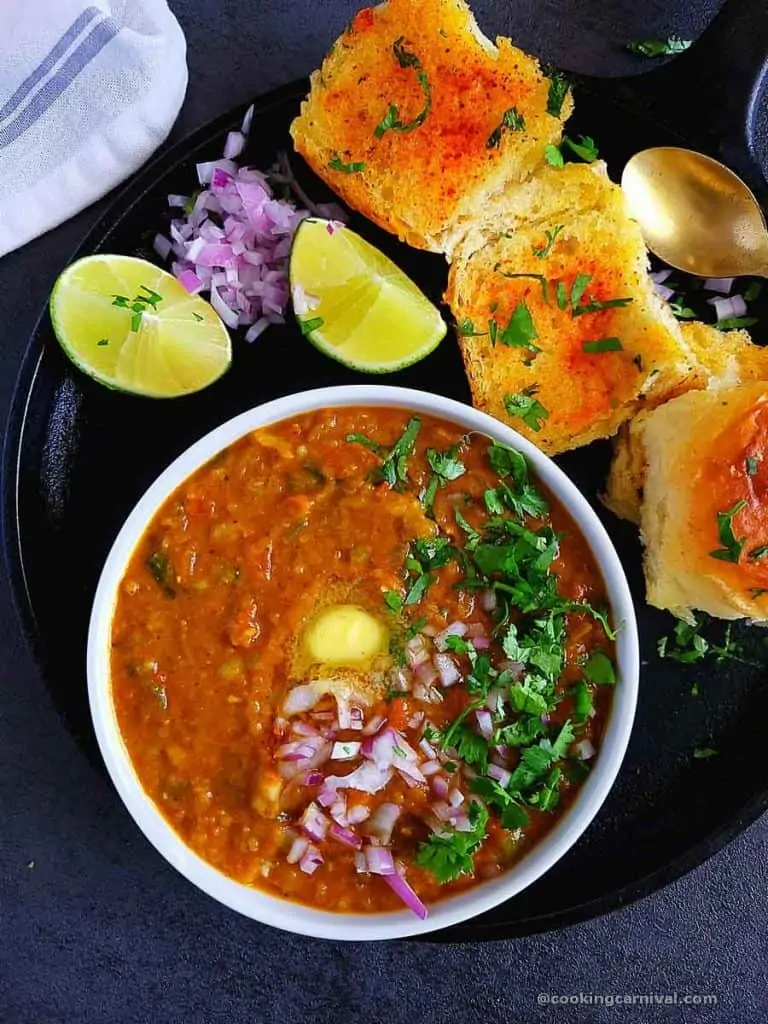
Notes, pro-tips, and quick FAQs
- To make this recipe, the proportion is everything. The ratio of tomatoes, onion to other vegetables is very important.
- You can use an equal amount of frozen or fresh green peas (matar) in place of the cooked dry peas when you want to cut down the time and process.
- Use good quality Kashmiri red chili powder to get the color. And also use a good quality of pav bhaji masala.
- A generous squeeze of lemon juice is just before serving.
- Use fresh garlic and fresh tomatoes.
- If you want the pav bhaji to taste just like Mumbai street style or fast food restaurant then do not compromise on the amount of butter used.
- Don’t forget lots of cilantro and chopped onions while serving the pav bhaji!
- Toast the pav in an ample amount of butter and serve immediately.
Pav bhaji isn’t healthy food! We have used potato, butter to make this recipe and also served it bread. So it should be enjoyed in moderation.
But to make little healthier (you need to compromise in taste then)
Substitute potato with raw bananas and add in loads of other veggies.
Use very minimal oil or butter or make the bhaji in vegetable broth
Swap Pav for rotis, dosas, parathas, or khakras.
I love Everest pav bhaji masala. There are several others like MDH, Badshah, etc. You can use the one you like! Or you can make masala at home too. (Scroll the page up or check the notes section in the recipe card for the recipe).
Absolutely! Substitute butter with oil and your vegan bhaji is ready.
If you have leftover bhaji, you can make masala pav, or spread it on dosa to make Pav bhaji dosa.
Definitely! It tastes the best the next day. The flavors mingle and deepen the next day. You can also do some prep work like boiling vegetables and green peas a day in advance and make the bhaji the next day.
Yes, you can. I have shared the Instant pot pav bhaji recipe here.
Guys, do try this recipe, this is the only recipe of Pav Bhaji you will ever need!
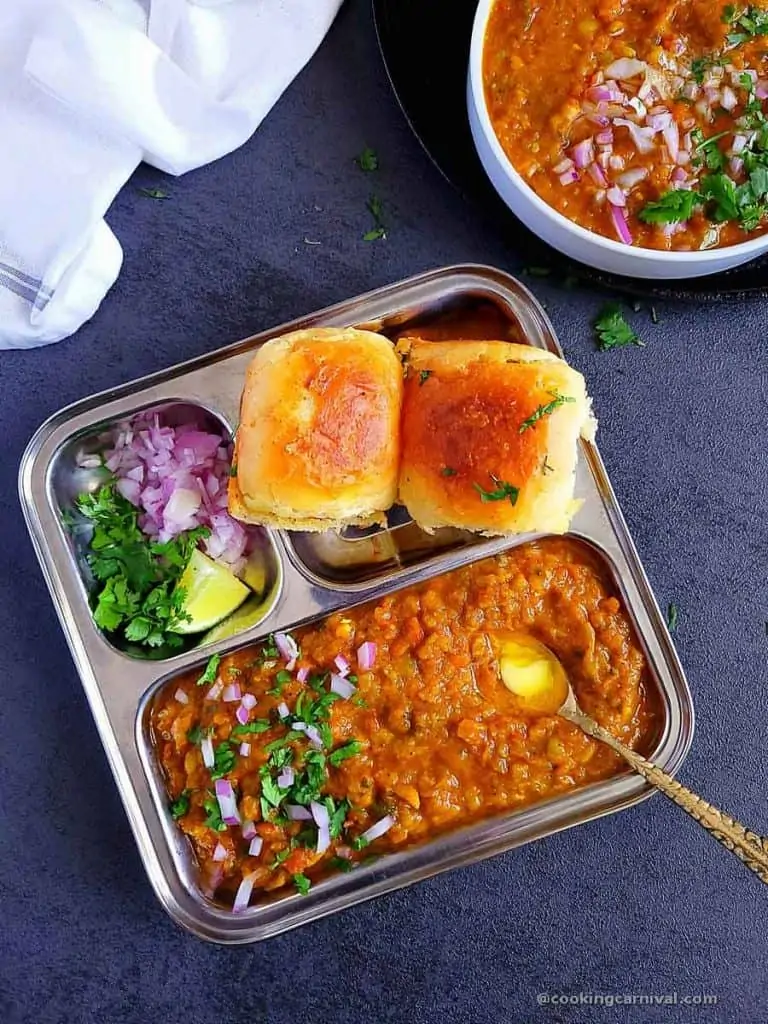
More Indian Street food recipes
Have you tried this Recipe? Please feed us with your feedback, ★ star ratings, and comments below.
You can also FOLLOW me on FACEBOOK, INSTAGRAM, and PINTEREST for more fabulous recipes and updates.
Subscribe to our YouTube Channel for tasty and easy video recipes.
Pav Bhaji
Ingredients
For paste
- 7 cloves Garlic Big (around 30 grams)
- 2 tablespoon Red kashmiri chili powder (Use ONLY kashmiri chili powder, don't substitute it with regular chili powder)
Other Ingredients
- 2 cups around 250 grams Potatoes (Peeled and cut into cubes)
- 1 cup around 120 grams – Cauliflower florets
- 2 cups Finely chopped Tomatoes
- 1 cup Finely chopped Onion
- 1 cup Finely chopped capsicum / bell pepper
- ¼ cup dried green peas (you can use ½ cup fresh or frozen green peas too)
- Salt to taste
- ½ teaspoon Turmeric powder
- 1 tbsp + ½ tsp Pav bhaji masala
- ¼ cup finely chopped cilantro
- 2 tablespoon Butter (I have used salted butter)
- 1 tablespoon Oil
- 1 teaspoon kasuri methi
- 2 teaspoon lime juice
8 Ladi pav/buns, cilantro, finely chopped onion, some lime wedges, and some butter for serving
Instructions
Step – 1 Soaking dried green peas (skip this step if you want to use fresh or frozen peas)
- I typically start with this step because it takes a while.
- Rinse dried green peas 2-3 times under cold water. Soak them in 1 ½ cup water overnight or for 8 hours.Notes – You can cook a big batch of dried green peas and freeze in one-time use portion size for whenever you want to make Bhaji.You can use fresh green peas(matar) or frozen green peas too instead of dried green peas.
Step 2 Cooking vegetables and soaked green peas.
- Once the green peas are soaked, discard the water. Place the soaked peas in a bowl, add ¾ cup of water, and cover the bowl. Keep it aside.
- Chop the cauliflower into florets. Peel the potatoes, and chop them into quarters. I like peeling mine before boiling. Take these vegetables into a bowl; add ½ teaspoon of pav bhaji masala and 1 cup of water. (if you are using fresh or frozen matar(green peas, add it with cauliflower and potatoes).
- Now take a pressure cooker add 2 cups of water, place the bowl of vegetables, cover it and place dried green peas bowl (Covered) on top.
- Now close the pressure cooker and take 7-8 whistles.
- Once pressure is down, open the pressure cooker and take out both the bowls.Note – The vegetables and dried green peas have be to cooked completely.
- Take peas and vegetables in a bowl and mash them together really well-using potato masher. Keep it aside.
- Making garlic chutney (do this step while the vegetables and dried green peas are presser cooking)
- Take garlic and Kashmiri red chili powder in a blender. Add ¼ cup of water and blend them into smooth chutney. Keep it aside.
Step – 3 Cooking Pav Bhaji
- Heat 1 ½ tablespoon butter and 1 tablespoon oil in a pan/pot.
- Now add garlic chutney and sauté for about a minute, stirring continuously.
- Now add onions, sauté for a minute and then add tomatoes, bell pepper, and salt.
- Saute everything for about a minute. Cover the pot and let everything cook for about 4 to 5 minutes on medium heat. Stir once or twice in between to make sure nothing is sticking to the pot.
- Open the lid, lower the heat and mash everything with a potato masher.
- Now add 1 cup of water, remaining 1 tablespoon pav bhaji masala, and turmeric powder. Mix everything well. Cover and again cook it for 6 to 7 minutes on medium heat. Make sure to stir occasionally and check-in between nothing in sticking to the pan.
- Now open the lid, stir the bhaji and again add ¾ cup of water and mix.
- Lower the heat, add mashed vegetable-dried peas mixture and mix well.
- Let it simmer for about 5 minutes on low to medium heat.
- Add Kasuri methi, cilantro, and ½ tablespoon butter. Mix well. Cook it for 1 minute and switch off the flame.
Step – 4 Toast the Pav
- To toast the pav, melt butter on a pan on medium heat. Sprinkle some pav bhaji masala and some cilantro on top of the butter halves the bun (pav) from the middle, and then place the buns on the pan.
- Press to toast the pav until crisp and golden brown from both sides.
Step – 5 Serve the Pav Bhaji
- To serve the pav bhaji, place a ladle full of hot bhaji on a plate. Sprinkle onion, cilantro and add a dollop of butter. Serve with toasted pavs and a side of a lemon wedge. Enjoy.
Video
Notes
- Very Important note – This pav bhaji recipe is very spicy. The spice level of this is ⅘. Reduce the amount of chili powder if you are making for kids or if you don’t prefer spicy bhaji.
- To make this recipe, the proportion is everything. The ratio of tomatoes, onion to other vegetables is very important.
- You can use an equal amount of frozen or fresh green peas (matar) in place of the cooked dry peas when you want to cut down the time and process.
- Use good quality Kashmiri red chili powder to get the color. And also use a good quality of pav bhaji masala.
- A generous squeeze of lemon juice is just before serving.
- Use fresh garlic and fresh tomatoes.
- If you want the pav bhaji to taste just like Mumbai street style or fast food restaurant then do not compromise on the amount of butter used.
- Don’t forget lots of cilantro and chopped onions while serving the pav bhaji!
- Toast the pav in an ample amount of butter and serve immediately.
- 1 tablespoon fennel seeds
- 1-inch cinnamon sticks (or 1 teaspoon cinnamon powder)
- 4 tablespoons coriander seeds
- 1 tablespoon cumin seeds
- 2 green cardamoms
- 5 cloves
- 1 teaspoon black peppercorns
- 2 count mace/javitri
- ¼ teaspoon turmeric
- ½ teaspoon black salt
- 1 tablespoon Kashmiri red chili powder
- 2 teaspoon Amchur Powder
Nutrition
Warm regards,
Dhwani.

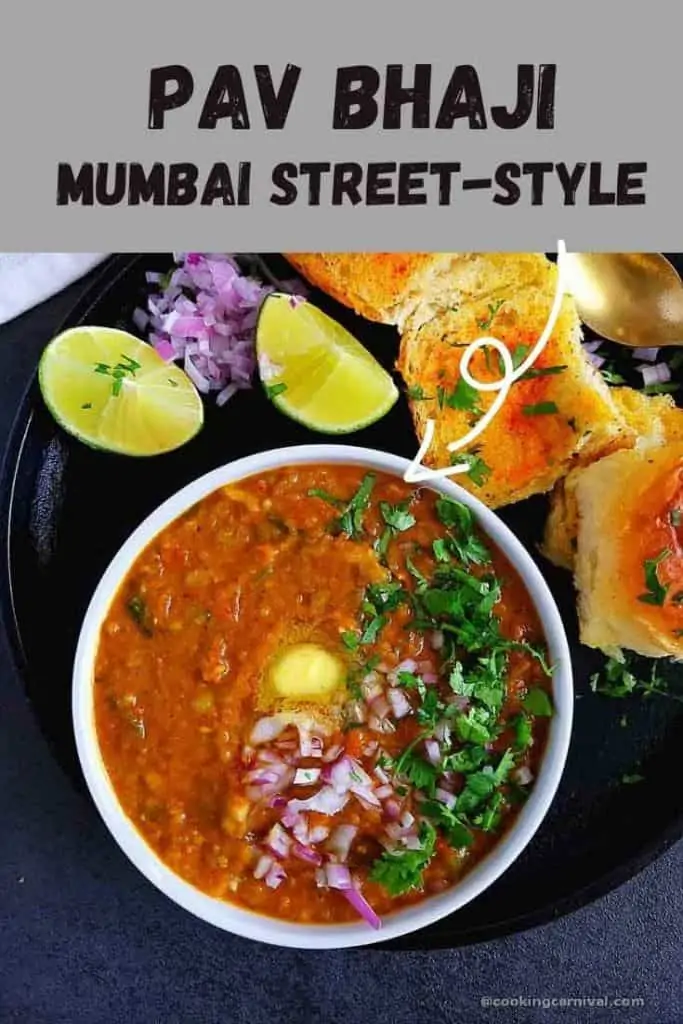
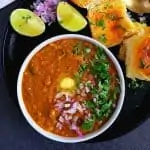
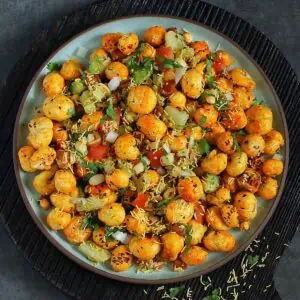
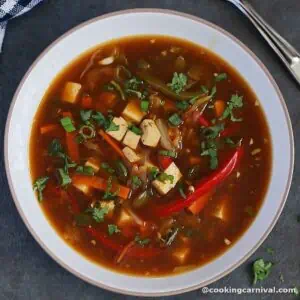
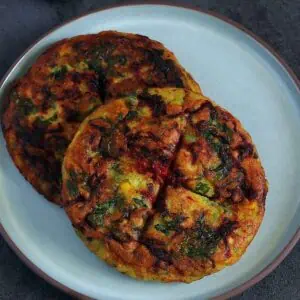
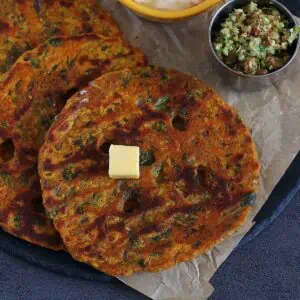

Love the colour of your bhaji.. it’s so mouth watering
Thank you Sushma!!
Looks droolicious! love the color 💗
Thank you, Freda!!